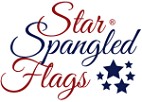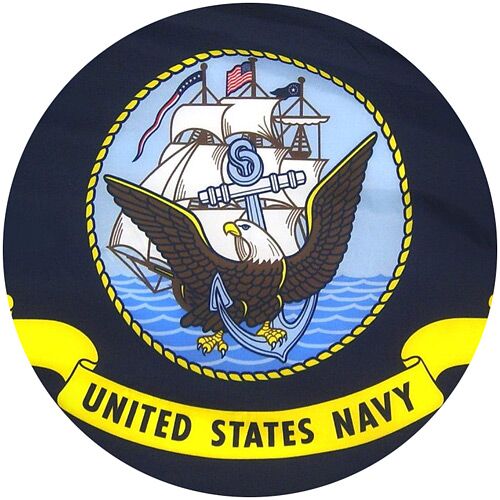- US Navy flag description
- US Navy flag reviews
- US Navy flag history
- US Navy flag facts
- US Navy flag FAQs
US Navy Flag Questions
Navy flags, Made in USA
All of our Navy flags are printed on our 200 denier thick nylon flag fabric. This special fabric is sun-protected and water resistant. The flag also features two brass grommets and 4 rows of stitching on the fly end, plus reinforced corners to prevent fraying. And as with all our flags, both materials and labor are 100% made right here in the United States. Add it to your shopping cart today and show your support for our troops!
Product Description
The U.S Navy flag of the United States Navy is used to represent its subsidiary units and formations that were adopted on October 13, 1775. The official flag is dark blue, with the seal of the U.S. Department of the Navy shown in the middle. Below is a yellow banner with the words “United States Navy” written across it.
The Navy flag is bordered with gold fringe for indoor and parade purposes, while the outdoor version has no gold fringe. The eagle on the flag represents the nation that the Navy protect and is situated standing on the anchor, wings open wide The anchor points to both the naval heritage of the Navy and their access to any coastline in the world. Behind both of these is a ship flying the American colors. The flag has one final component: below the emblem is a ribbon that reads, “United States Navy.”
The Navy flag flies on many occasions such as ceremonies, parades, installations, and more. In addition, the flag is also displayed in the offices of the United States President, Secretary of Defense, Secretary of the Navy, and the Chairman and Vice Chairman of the Joint Chiefs of Staff.
Origins of the US Navy Flag
While the U.S. Navy has been around since 1775, it didn’t have an official flag until the mid-1900s. Instead, the U.S. Navy had an unofficial flag. Known as the Infantry Battalion Flag, it featured a dark blue-colored anchor against a white diamond. The U.S. Navy continued to this unofficial flag for many years. It wasn’t until the mid-1900s when it adopted an official flag.
The origins of the modern-day U.S. Navy flag can be traced back to April 24, 1959. On this day, President Dwight D. Eisenhower authorized an official flag for the U.S. Navy. The legislation, Executive Order 10812, established an official U.S. Navy flag consisting of the U.S. Department of the Navy above a yellow scroll with the words “United States Navy.”
The U.S. Navy flag features a uniform design. It measures approximately 4 feet and 4 inches wide and 5 feet and 6 inches long. It may also feature fringe. According to the design specifications, the fringe on the U.S. Navy flag must be yellow, and it should measure 2.5 inches wide. The design of the U.S. Navy flag follows these specific guidelines.
The US Navy Flag Today
Since being officially adopted in 1959, the U.S. Navy flag hasn’t been changed. It continues to feature the same aforementioned design. And you’ll often see the U.S. Navy flag at ceremonies, parades, public gatherings and events authorized by the Secretary of the Navy.
It’s important to note that the U.S. Navy flag is not displayed on ships at sea; it’s displayed strictly on land.
Another fun fact about the U.S. Navy flag is that there are no tassels or cords authorized for it by the U.S. Navy. Rather, the U.S. Navy flag is displayed by itself without any tassels or cords. Other types of flags may have tassels or cords, but you typically won’t find them on the U.S. Navy flag. Hopefully, this gives you a better understanding of the history of the U.S. Navy flag.
#1) Authorized By President Eisenhower
The U.S. Navy flag was authorized by President Dwight D. Eisenhower on April 24, 1959. In Executive Order 10812, President Eisenhower recognized it as the official flag for the U.S. Navy, which replaced the previously used battalion flag. Shortly thereafter, the U.S. Navy flag was introduced to the public during a ceremony at a Navy facility in Maryland.
#2) It’s Not Flown on Ships
Being that it’s the official flag of the U.S. Navy, you may assume that it’s flown on the Navy ships and boats. The Navy, however, actually displays it exclusively indoors and during special outdoor ceremonies and occasions. Therefore, you won’t find the U.S. Navy flag displayed on ships, boats or other Navy-operated land installations. The only time when it’s flown outdoors is during special occasions like ceremonies and parades.
#3) No Cords or Tassels
Unlike with many other flags, the U.S. Navy flag doesn’t have any cords or tassels — at least none are supported by the flag’s official design. Executive Order 10812 specifically states that no cords or tassels should be used with the U.S. Navy flag. So, if you’re thinking about buying a U.S. Navy flag to display in your home or business, you should check to make sure that it doesn’t contain cords or tassels.
#4) The Eagle Symbolizes the US
The eagle located in the middle of the U.S. Navy flag is meant to symbolize the United States. The eagle, of course, is placed in front of a large ship. The ship symbolizes the Navy, whereas the eagle symbolizes the United States. As a result, the U.S. Navy flag shows how the Navy protecting the United States.
#5) It Replaces s the Infantry Battalion Flag
The current U.S. Navy flag replaced the Navy’s former infantry battalion flag. Prior to its formal adoption in 1959, the U.S. Navy used the infantry battalion flag, which consisted of a ship anchor on a white diamond against a blue background. While the U.S. Navy no longer recognizes or uses the infantry battalion flag, it does use colors from this traditional flag design for landing battalions.
- When and by Whom was the U.S. Navy Flag introduced?
- Where is the U.S. Navy Flag used to represent the Navy?
- What are the designs on the U.S. Navy Flag and what do they represent?
- How should you display the U.S. Navy Flag when in the presence of other flags?
- Where can I purchase a Navy Flag only made in the U.S.A.?
When and by Whom was the U.S. Navy Flag introduced?
Executive Order 10812 of 24 April 1959, the President, Dwight D. Eisenhower, upon the recommendation of the Secretary of the Navy with the approval of the Secretary of Defense, established and prescribed an official flag for the United States Navy. The Navy Flag was formally introduced to the public on April 30, 1959 at a ceremony at a Naval Support Facility in Maryland. It replaced the infantry battalion flag which had been used as the U.S. Navy’s unofficial flag for many years beforehand.
Where should the U.S. Navy Flag be used to represent the Navy?
The U.S. Navy Flag will represent the Navy at official ceremonies, parades, during official Navy display occasions, at public gatherings when the Navy is an official participant, and other such occasions as may be specifically authorized by the Secretary of the Navy. When used for these purposes, the U.S. Navy flag will accompany and take the place of honor next after the Flag of the United States.
What are the designs on the U.S. Navy Flag and what do they represent?
The Navy flag is bordered with gold fringe for indoor and parade purposes, while the outdoor version has no gold fringe. The eagle on the flag represents the nation that the Navy protect and is situated standing on the anchor, wings open wide. The anchor points to both the naval heritage of the Navy and their access to any coastline in the world. Behind both of these is a ship flying the American colors. The flag has one final component: below the emblem is a ribbon that reads, “United States Navy.”
How should you display the U.S. Navy Flag when in the presence of other flags?
When flying the Navy Flag on the same pole with the American flag, it should fly directly below the American Flag and be the same size or better yet, smaller. If you fly any state flags on this same pole, they will go above the Navy flag and below the American Flag. If you fly multiple military flags they should be flown in this order: Army, Marine, Navy and Air Force.
Where can I purchase a Navy Flag only made in the U.S.A.?
Star Spangled Flags sells the Navy Flag and it is 100% made in the U.S.A. Their flags are treated to dry fast and resist sun and chemical deterioration which keeps the colors bright and strong against the ultraviolet rays in the bright sunshine. They also use a very strong nylon material and two rows of superior lock stitching, and the fly end has 4 rows of lock stitching to prevent unraveling and fraying improving its longevity.



3 reviews for US Navy flag